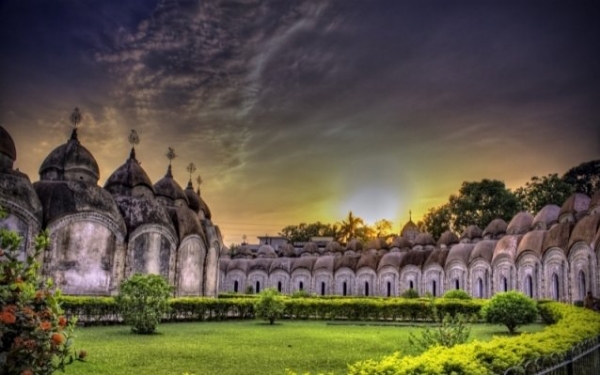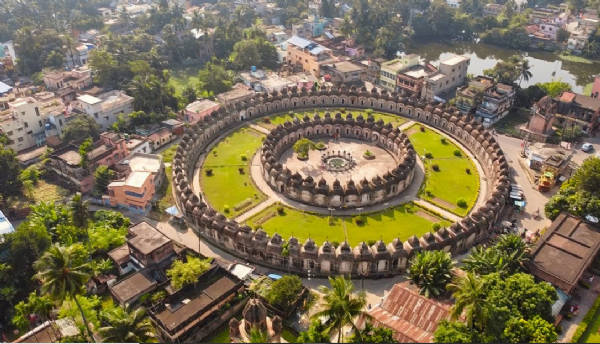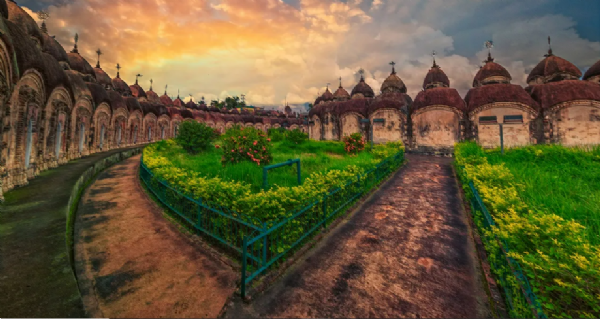108 Shiv Mandir - the most unique temple complex in West Bengal
The temples here are built in two concentric circles centering a well, the outer arc having 74 temples and the inner circle having 34 temples.
Total Views |
Have you ever heard of the temple complex having 108 temples AND being built concentric circles to form a beautiful illusion of infinity? Let us explore just that today, and yes, it is just as beautiful as we described, if not even more. Located on the western bank of the Hooghly River, Kalna is a beautiful city in situated in West Bengal. Alternatively known as the Ambika Kalna after the Goddess Maa Ambika Kaali, Kalna is most famous for its intricate terracotta temples built in the late 18th century by the Maharajas of Bardhaman.

History | It is said that Rani Bishnukumari, the widowed wife of Raja Tilakchand, received divine dreams of constructing a temple of Lord Shiva in the area. The temple was then built by Maharaja Tej Chandra Bahadur in 1809 AD to celebrate the transfer of power of the royal estate of Bishnupur. Hence, the Ambika Kalna 108 Shiv Mandir was constructed in the year 1809 by Maharaja Tej Chandra Bahadur. 

Did you know? There are actually two 108 Shiv Mandir / Shiv Temples in Bardhaman. One is located at the Kalna in Purba Bardhaman district, and the other one is located near the Nababhat in Bardhaman City.

We are about to look into the most unique and exquisite temple in Kalna – the 108 Shiva Temples Complex. An architectural marvel that was built by Maharaja Tej Chandra Bahadur back in 1809, it is a combination of two concentric circles - each of which have small temples dedicated to Lord Shiva. The temple is also called as the Navakailasha temple.
A wonderful example of art work and architecture, the temple creates an optical illusion of infinity, as the concentric circles actually form an eternal ring having no beginning or end. The small temples represent beads of a rosary and the walls have the carvings from the scenes of epics Ramayana and Mahabharata.
Of the two concentric circles, the first one has 74 temples having white marble and black stone Shivalingas, and the second one has 34 temples with Shivalingas of White marble. Because of its ingenious architectural planning - all the Shivalingas here can be seen from the centre of the temple complex.
History | It is said that Rani Bishnukumari, the widowed wife of Raja Tilakchand, received divine dreams of constructing a temple of Lord Shiva in the area. The temple was then built by Maharaja Tej Chandra Bahadur in 1809 AD to celebrate the transfer of power of the royal estate of Bishnupur. Hence, the Ambika Kalna 108 Shiv Mandir was constructed in the year 1809 by Maharaja Tej Chandra Bahadur.
Architecture | The temples of the Nava Kailash or the 108 Shiv Mandir are actually conjoint, having a more or less domical type of architecture, and are built of Atchala bricks. The temples are built in such a way that they have a unique numerical combination. The temples here are built in two concentric circles centering a well, the outer arc having 74 temples and the inner circle having 34 temples.

108 is a spiritual number in Hindu mythology representing rosary beads. The outer arc has alternate shiva temples that have black and white shiv linga respectively. The inner arc temples all have white shiva linga. The temple is also known as Navaratna.
Also Read | Ashapuri temple complex, the 1000-year-old glory of Bhopal
In the ancient past, the temples were taken care of by 12 priests and they used to worship the Shiva lingas every single day. The walls of temples have inscriptions of Ramayana and Mahabharata.
It is said that the white Shiva linga which stands for the calm & quiet form of Shiva and the black Shivalinga is the Rudra or the angry form of Lord Shiva.

Moreover, it is also believed that the white and black Shiva linga represents the outer world, the world we live in that is the world of sins, guilts, sacrifices involving both good and bad deeds, and the inner white Shiva linga symbolizes pure inner thought of heart and lessening of pain, wrongdoings attained through prayers offered in the feet of Lord Shiva.
Also Read | Lenyadri Girijatmaj Ganpati Temple: An enigma in Junnar
This temple is well maintained by the authorities. You will find the place brimming with green lawns in the temple premises. The gardens have various vibrant coloured flowers.
Did you know? There are actually two 108 Shiv Mandir / Shiv Temples in Bardhaman. One is located at the Kalna in Purba Bardhaman district, and the other one is located near the Nababhat in Bardhaman City.


